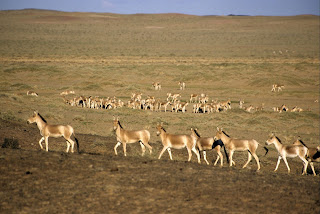 |
| Khulans on the hiill (c) Petra Kaczensky |
The Gobi desert, a vast expanse of arid land in China and
Mongolia, is home for herds of animals such as the Asiatic wild ass (Equus
hemionus, locally called “khulan”).
Individual khulan roam over areas of thousands of square
kilometres. The scale of their movements is among the largest described for terrestrial
mammals, making them especially difficult to study.
It is possible to track the movement of individual animals
using GPS satellite telemetry. However, the technique does have limitations - it
misses important information such as details of interactions with other animals
and humans.
Now further light has been shed on the activities of the
Gobi khulan by an international research team led by Vetmeduni Vienna using a new
type of satellite collar which included a camera.
The results of the research project have been reported in
the journal PLOSOne.
As well as providing information pertinent to science and
wildlife conservation, the images also offer the general public exciting new
insights into the way of life of a far-ranging species in a very remote and
challenging environment.
The team of researchers from Vetmeduni Vienna, the Wildlife
Conservation Society, the National University of Mongolia and the Norwegian
Institute for Nature Research, used a satellite collar with an integrated
camera to gain new insights into habitat use, life history and potential
threats khulan face in the Gobi. The deployment of this innovative camera
technology on an adult khulan mare resulted in several thousand images over a
one-year-period.
“The images provided us with important new insights into life
history events of this mare and other khulan. The images allowed us to document
khulan behaviour near human infrastructure, where and when the animals gathered
in larger groups, and the frequency of encounters with semi-nomadic herders and
their livestock,” says lead author Petra Kaczensky from the Research Institute
of Wildlife Ecology at Vetmeduni Vienna and the Norwegian Institute for Nature
Research.
The image material also allowed an estimate of the
availability of water at different times and at different places. “The success
of our pilot project shows the added value of deploying camera collars on
animals in remote, highly variable ecosystems for research and conservation
purposes,” adds Sanchir Khaliun from the National University of Mongolia.
The migratory behaviour of khulan puts them especially at
risk from the influence of human activities, in particular concerning the need
for regular access to water and pasture lands.
“The new camera technology has
allowed us to gain information about important life history events, e.g. when
and where the collared khulan’s foal was born. And the images allow us to draw
conclusions about behaviour, for example, that khulan seem to avoid people and
their livestock. The images also make it possible to better determine the
impact of local weather conditions on water availability and, consequently, on
nomadic movements than had previously been the case,” says Chris Walzer from
the Research Institute of Wildlife Ecology at Vetmeduni Vienna and the Wildlife
Conservation Society.
According to the study’s authors, images from camera collars
also have an enormous PR potential, as documented by an increasing number of
images used in popular science articles, books or documentaries. These images
and videos provide insight into the secret lives of animals and are guaranteed
to attract public attention.
“The newly developed camera collar is therefore an important
tool to communicate new research findings to the public, develop attractive
educational material and raise awareness for conservation issues,” says Petra
Kaczensky.
A selection of images from the camera collar can be seen at:
For more details, see the open access article:
Through the
eye of a Gobi khulan – Application of camera collars for ecological research of
far-ranging species in remote and highly variable ecosystems.
Kaczensky P,
Khaliun S, Payne J, Boldgiv B, Buuveibaatar B, Walzer C (2019)
PLoS ONE 14(6): e0217772.

No comments:
Post a Comment